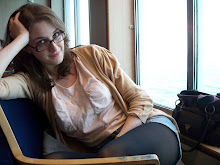The first exhibition solely dedicated to the work of Anish Kapoor outside of London features sculptures and installations made from pigment, wax, stone and stainless steel. Personally I think these materials collaborate well together, rather than fight for attention in the same room. The first sculpture I came to was 'Moon Shadow' 2005, made from wood, wax and an oil-based paint. I liked this sculpture as I felt it had a hidden drama to it; the wax and paint mixture made it look like it was still wet and had only been flung up onto the wall moments ago, the viewer is witnessing the few seconds before it falls from the wall and becomes a different piece of work entirely. The suspense and tentative nature of Kapoor's works makes them distinguished against other artist's.
 |
| 'Moon Shadow' |
"I don't wish to make sculpture about form - it doesn't really interest me. I wish to make sculpture about belief, or about passion, or about experience that is outside of material concern." Anish Kapoor 1981
'Turning the World Inside Out' 1995, made from stainless steel is a welcome piece amongst the sculptures made from wax and pigment. The reflective nature of the steel works well with the bold colours such as red, and yellow in the room. I feel the sculpture is quiet in form; smooth curves of steel seem humble against the spikes of the pigment and wax pieces. For me, the title of 'Turning the World Inside Out' seemed the most literal of all. The sculpture could be the world itself; turning inside out and imploding. Or it could be turning the world which surrounds the sculpture turning inside out. Due to it's reflective nature, it seems to be sucking inward the surrounding environment.
 |
| 'Turning the World Inside Out' |
'When I am Pregnant' by Kapoor, 1992, made from fibreglass, wood and paint, blurs the lines between work and gallery so much, this sculpture almost goes unnoticed. A subtle bump in the wall of the gallery, it is only really seen from the side, if this sculpture is looked at from straight on, it almost completely disappears as it is painted perfectly into the gallery wall
'Void' 1994, fibreglass and pigment, was another favourite of mine. A dome, which reminded me of half an egg-shell shape, had a deep purple exterior and a blackened interior. It is obvious to see that to get colour of this depth and intensity, pigment was Kapoor's only choice. The title of void, comes from the uncertainty of the blackened interior. When looking at this sculpture I studied it hard to decide whether it was a flat surface or if it did in fact curve inwards; the intensity of the colour makes this unbearably hard to figure out. With Kapoor's work, the voids envelope the viewer.
 |
| 'Void' |
'White Sand, Red Mullet, Many Flowers' 1982, mixed media and pigment, was what looked like the centre-piece of the exhibition. In the centre of the room, the sculptures looked like sandcastles of pigment, in red, yellow, and black. His use of pigment is clearly directly influenced by his Indian heritage and upbringing in India. The sculptures look like sandcastles that are precise and accurate in form. They look soft and crushable yet their form and structure appear strong. I like the visible tension between soft materials and solid forms.
 |
| 'White Sand, Red Mullet, Many Flowers.' |
























